Estimated reading time: 6 minutes
Removing fruit tree suckers is an important part of pruning your fruit trees. They’re sometimes called watershoots, but in fact, watershoots are something entirely different.
Pruning is one of the 5 key fruit tree jobs. Whether you’re pruning in summer or winter (or any other time for that matter), removing suckers is an important part of the job.
So, we thought we’d share some tips about how to remove them properly.
What’s a sucker?
Good question! Suckers are shoots growing from below the graft union on your tree. Sometimes they’re growing directly from the roots and coming up through the soil near the trunk of the tree.
Most fruit trees have been grafted. This means that shoots from below the graft union are growing from the rootstock, rather than from the variety.
Watershoots are something different. Just like suckers they are strong, vertical shoots, but watershoots grow from above the graft and need dealing with differently.
Why should you always remove fruit tree suckers?
There are three very good reasons why you should always remove these shoots from your fruit trees.
It’s often better to illustrate these things rather than talk about them. Suckers are pretty common, so we have lots of photos from our orchards to demonstrate what we’re talking about!
This photo shows the first reason why this is so important:

Can suckers get as big as the tree?
This is a little plum tree with two suckers coming up from the roots. Notice how they’re pretty much the same diameter as the original tree? In just one year, both suckers have grown taller than the tree.
Just imagine, for a minute, what this scenario would look like in another year or two if the suckers were left intact.
Within a very short space of time, the original grafted tree would become increasingly difficult to distinguish. In fact, the suckers would likely out-compete the original tree, increasing its chances of dying.
If you have a multi-trunked fruit tree in your garden, this is one of the common explanations for how it got there.
Here’s another example that shows just how much stronger suckers often are than the grafted tree:
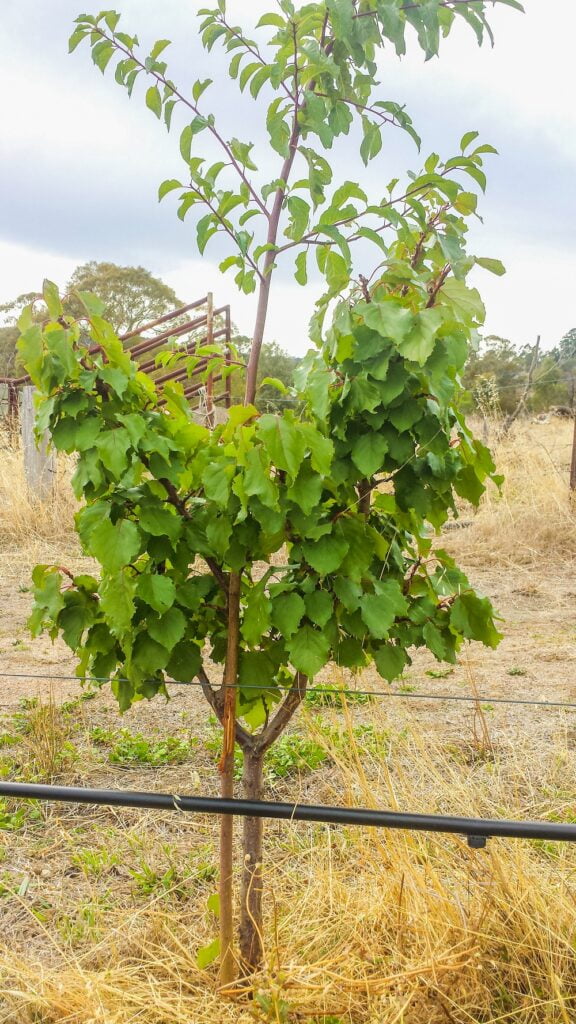
How to avoid making the problem worse
That brings us to the second reason for getting this technique right.
When you’re removing suckers, make sure you take them off as close to the trunk or the ground as you possible can.
This can be quite tricky to do with your secateurs if they’ve already grown very large. The one in the photo below is probably on the edge of what’s possible. You may need to get out the pruning saw, or even the chainsaw!
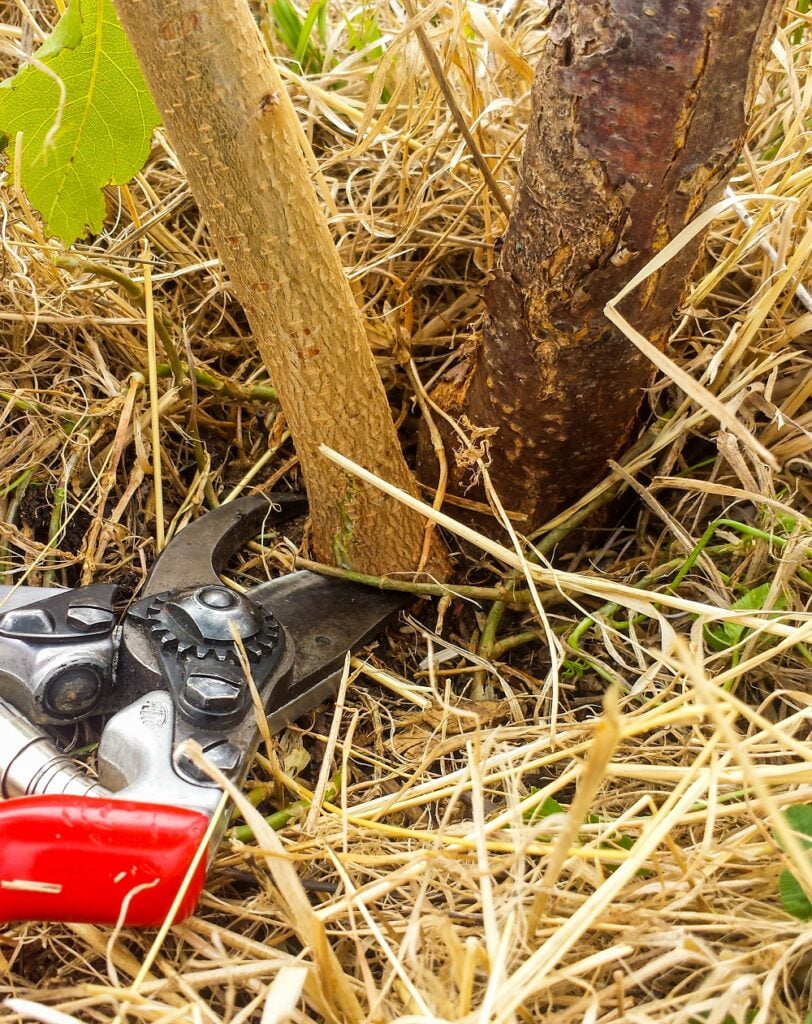
Fruit tree suckers tend to be persistent and come back every year anyway.
If you leave a stub, you’re just asking for trouble. This is effectively pruning it off with a heading cut.
The likely result?
It’s pretty much guaranteed to branch. Don’t be surprised if you come back next year and find that one sucker has turned into a forest.
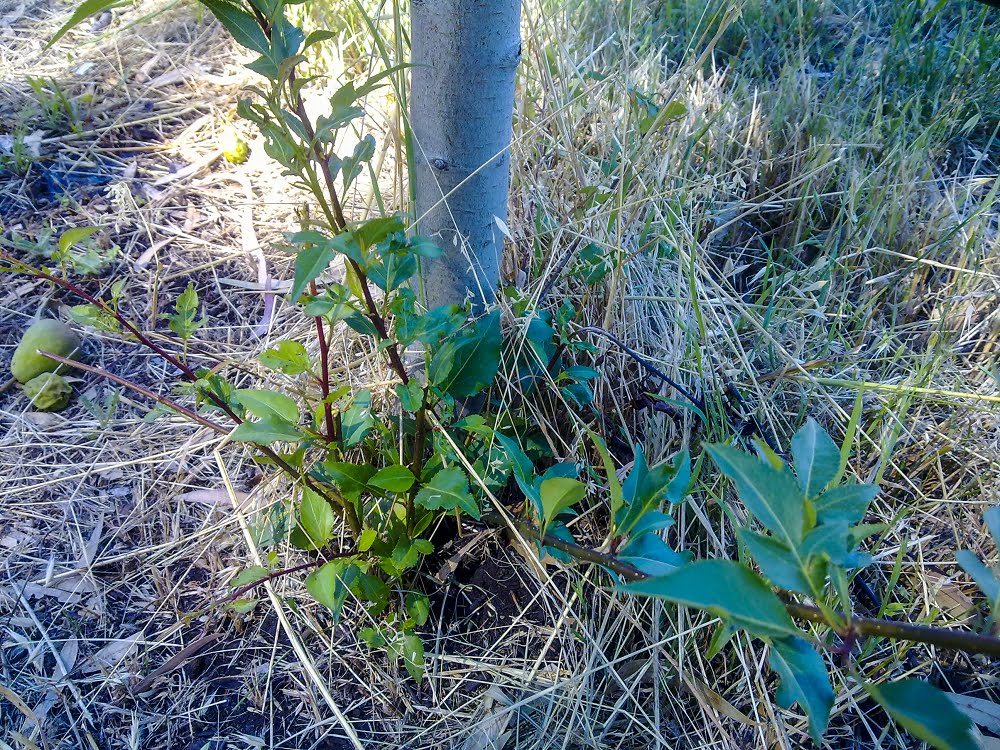
Keep your garden safe from fruit tree suckers
The third excellent reason to remove suckers is because they can be quite dangerous.
Many rootstocks are quite thorny. Because the suckers grow so vigorously, the thorns can quickly become really strong and vicious.
Here’s one we prepared earlier.
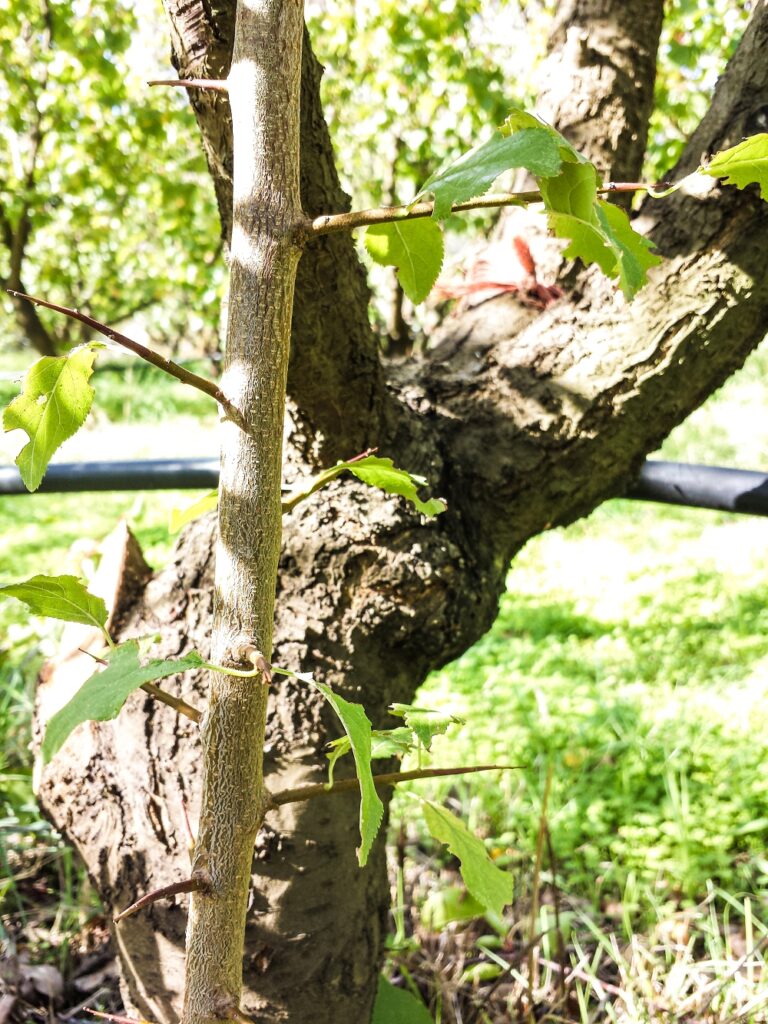
There are a few reasons why they form major hazards in your garden.
The one we’ve photographed here had grown more than 2 metres tall in just one season. It had also grown right up through the tree. This not only takes much-needed vigour away from the tree but also provides a potentially painful hazard when you’re thinning, picking, or pruning.
How to dispose of suckers
Be very careful with how you dispose of suckers once you’ve cut them down. Make sure you put them well out of harm’s way.
Don’t leave them where they can be driven over. They can easily puncture even a tractor tyre (and yes, that’s the voice of experience!)
Particularly, make sure you don’t leave them lying where someone might accidentally step on one. Those thorns can be sharp and strong enough to penetrate most shoes, including sturdy work boots.
And you definitely don’t want to experience a puncture wound from them. These wounds can be as painful and problematic as severe insect bites.
Suckers can be dealt with in the same way as any other prunings, as long as you’re careful of the thorns in the process. They also lend themselves to making backyard biochar, which is a terrific way of quickly improving your soil.
Can you replant fruit tree suckers?
Yes, sometimes. We’ve done it many times, and in fact, we dig up cherry suckers every year for use in Carr’s Organic Fruit Tree Nursery.
If the sucker is growing from under the soil (as opposed to straight out from the trunk) it may have roots on it. Excavate the soil carefully around the sucker to have a look.
If there are roots, dig a bit deeper, then cut off the sucker with as many roots as possible. Plant it straight away and water it in. It will make a fantastic rootstock to get you started on a grafting adventure!
Related Articles
The top 4 fruit tree espalier mistakes to avoid
Espalier can be beautiful and productive way to grow your fruit trees—if you avoid these 4 common mistakes.
How to know if your fruit tree flowers are healthy
Learn how to spot the difference between healthy fruit tree flowers and those that are suffering from a common disease that can cause rot.
Do your fruit trees have the right pollination partners?
Estimated reading time: 6 minutes Pollination partners for fruit trees are one of those things that most gardeners have heard of, but few really…

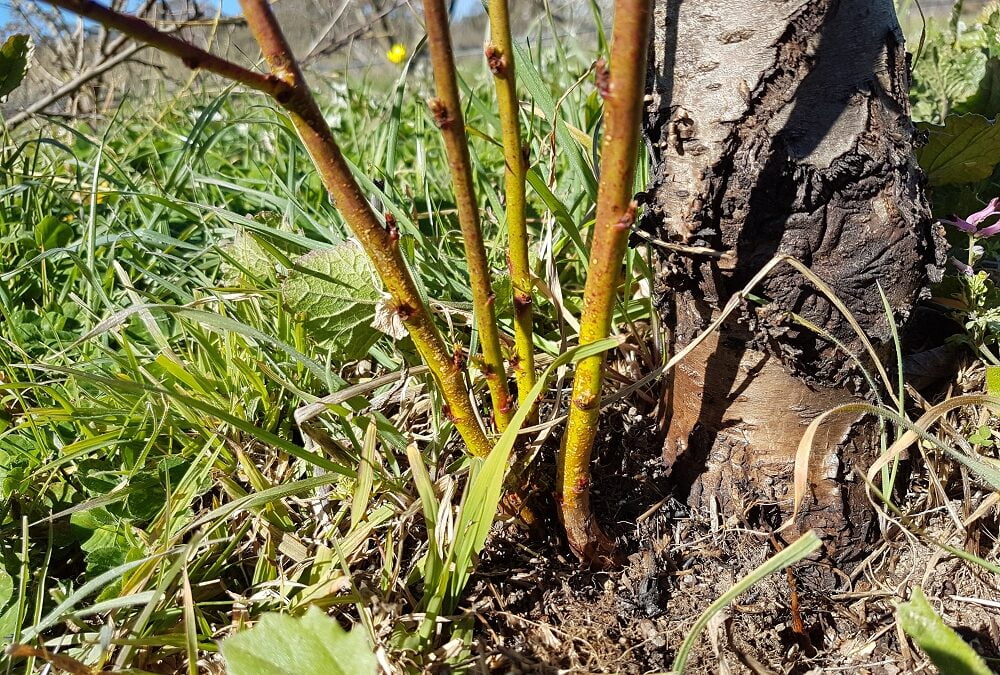






Good tip
Thanks Cathy, glad you’re finding our info useful!
So I didn’t remove the suckers (right away) from a potted apple and last season when I repotted the plant ended up with several suckers with roots, so pruned them off and repotted them just to see how they do. They’ve now been going strong all summer. Now I have some practice specimens this winter for learning to graft!
That’s so great Kelly, what a great thing to do with suckers – talk about not letting anything go to waste (plus, you’re getting free fruit trees!). Excellent job.
can you plant suckers as fruit trees? my father’s almond tree has sucker from the roots. is there a special way to plant the suckers once they have been removed from the roots?
Hi Mustafa, try to cut the suckers off with some roots if possible, then yes, you can plant it as a new tree. However, it’s a rootstock, not the same variety of almond, so it will need grafting. You can use the original tree to harvest some wood for grafting, and that will turn it into the same type of tree as your dad’s. If you can’t harvest the rootstock with any roots, then try cutting it into 20cm pieces (cuttings), and store them with the bottom 5cm in damp sand to see if they will start growing roots. After a few months you should be able to see a ring of white tissue (called callus) around the base, which is where the roots will start growing. At that point you can plant them in a pot or the ground to grow your rootstock. To find out more about grafting you might want to check out our grafting courses – https://growgreatfruit.com/product-category/grafting/
Very good post! We are linking to this particularly great article on our site.
Keep up the great writing.
great tips! thank you!
Are you able to replant the suckers straight away or do you need to grow new roots?
Great question Bec – if you’re lucky enough to be able to cut the suckers off with some roots, go ahead and plant them. If not and you want to use it to create new rootstocks, you’re better to remove the sucker in winter while it is dormant, cut it into 15-20 cm lengths, and store them with the bottom 1/3 in damp sand until spring. Then check whether they’ve developed a callus on the bottom – if so, this is a good indication they’ll grow roots, and you can go ahead and plant them in a pot or the garden.
Thanks for your email with good info, I have two potted cumquats, one is constantly sending up suckers one doesn’t. I also have a lime tree that has a tendency to really fast growing super thorny suckers.
I have an unrelated question, I have a miniature nectarine, planted about seven/eight years ago. It’s given virtually no fruit, maybe a couple of miserable looking small nectarines over the years. It hasn’t grown much, it’s about a metre high, gnarled, looks more like a Japanese bonsai.
I’m tossing up whether to just pull it up and toss it or whether there’s something else that I can do.
Can you give me an idea of what you would do
Love your newsletters
Ann
Hi Ann, your nectarine doesn’t sound very happy! It always worth trying to improve the soil to see if you can get a recalcitrant tree growing – aeration, good quality compost and some worm castings. Also a vigorous prune may stimulate it to start growing. Good luck!
I came from a nursery one day with a pear tree and unfortunately somehow managed to break two of its long branches in the transport home so now two years on it’s still a tall and narrow tree. How can I get it to bush up and not just grow tall?
Hi Karen, great question – it’s really important to prune the tree back really hard with heading cuts, that way it will start branching out nice and low in the tree. It’s all explained in our short course about establishment pruning – https://growgreatfruit.com/product/pruning-young-fruit-trees/. It would be a really good idea to do the pruning this winter, before the tree starts growing again next spring.
Hi, I’ve been asked to prune a neighbour’s mature plum tree and discovered it has two suckers that have grown to be larger than the main tree. The main tree is about 10 ft tall and the suckers are about 12 feet! Is there a risk to the rootstock if I cut out so much of the tree at one time? Should I perhaps spread the work across two years?
Thanks,
Dave
Hi Dave, great question – no, don’t delay, remove those suckers ASAP! They taking valuable energy away from the main tree, so the sooner they’re both gone the better
Can I turn suckers into a new plum tree. Our excellent plum tree blew down and had to be removed. Now suckers have appeared. Will these grow into a new tree?
I did not notice suckers on an apricot tree, they have grown under the timber slats on deck. I will cut these off as instructed, but if I cut off as close as I can reach will be be enough.
Helen
Hi Helen, great question. If you trim suckers, they really need to be cut back as close to the tree as possible. If you prune them and leave any stub, you will actually be adding vigor to the suckers and encouraging them to grow more! Good luck, Meg – GGF team.
My cherry trees keep having suckers. I cut them off when they are about 4 or 6 inches tall. There are lots of them. Am I doing something wrong to cause all the suckers? Are the trees “unhappy”? Is there a way to prevent them from recurring?
John
Hi John, are you cutting the suckers off very low down (digging down a bit, as we mention in the blog, is really important). Cutting them off too high is effectively a heading cut which actually encourages more vigour and growth, so it’s very important to get down low. Once a tree suckers, it’s likely to continue being a maintenance job, but doing it thoroughly can make a big difference. Meg – GGF team.
My two 30 year old apricot trees are gradually producing less and less fruit, and now that our California drought is over, I want to start growing replacements. I have potted 2 bareroot trees which I will plant next year. And I also have 2 root suckers that are growing 4-5 feet from the original tree, (outside of the canopy) and in the perfect place to plant a new tree. I did not distroy the suckers during the drought because the local arborist said they were helping the tree stay alive.
I have read here how to turn a root sucker into root stock by digging it up with some roots, but can I leave it in place and graft onto it? Since it is in the perfect location, I expect that having the rootstock already growing and happy will give the new grafted tree a head start. I assume that I have to dig down between the trunk and the sucker, find the root from the older tree that the sucker is coming from, and sever the connection. But I am not sure. What do you advise?
If root suckers are in a good place thats perfect. Graft when you can and enjoy having a tree with jump start, in a first few years it grows much faster than new tree since it alredy has a lot of roots
I am removing an apricot tree that has sprouted suckers in quite a few places. I’ve pulled the tree out but had to cut off some of the roots as they go deep. I’ve also dug down to get a decent amount of root from the suckers as well. Have I done enough to stop the tree growning back? I would very much appreciate your advice!
Hi Marly, you will probably find the tree roots continue to throw up suckers for some time. You just need to persist in digging them out when they appear. Apripots are notorious for this as they are so vigorous.